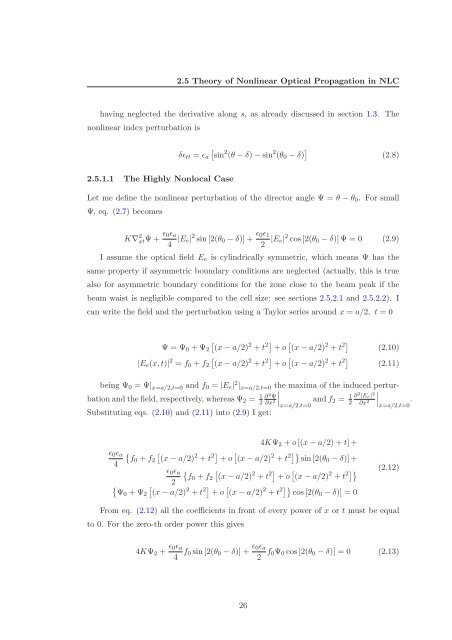Solitons in Nonlocal Media
Solitons in Nonlocal Media
Solitons in Nonlocal Media
You also want an ePaper? Increase the reach of your titles
YUMPU automatically turns print PDFs into web optimized ePapers that Google loves.
2.5 Theory of Nonl<strong>in</strong>ear Optical Propagation <strong>in</strong> NLC<br />
hav<strong>in</strong>g neglected the derivative along s, as already discussed <strong>in</strong> section 1.3. The<br />
nonl<strong>in</strong>ear <strong>in</strong>dex perturbation is<br />
2.5.1.1 The Highly <strong>Nonlocal</strong> Case<br />
2 2<br />
δǫtt = ǫa s<strong>in</strong> (θ − δ) − s<strong>in</strong> (θ0 − δ) <br />
(2.8)<br />
Let me def<strong>in</strong>e the nonl<strong>in</strong>ear perturbation of the director angle Ψ = θ − θ0. For small<br />
Ψ, eq. (2.7) becomes<br />
K∇ 2 xtΨ + ǫ0ǫa<br />
4 |Ee| 2 s<strong>in</strong> [2(θ0 − δ)] + ǫ0ǫ1<br />
2 |Ee| 2 cos [2(θ0 − δ)]Ψ = 0 (2.9)<br />
I assume the optical field Ee is cyl<strong>in</strong>drically symmetric, which means Ψ has the<br />
same property if asymmetric boundary conditions are neglected (actually, this is true<br />
also for asymmetric boundary conditions for the zone close to the beam peak if the<br />
beam waist is negligible compared to the cell size: see sections 2.5.2.1 and 2.5.2.2). I<br />
can write the field and the perturbation us<strong>in</strong>g a Taylor series around x = a/2, t = 0<br />
2 2<br />
Ψ = Ψ0 + Ψ2 (x − a/2) + t + o (x − a/2) 2 + t 2<br />
|Ee(x, t)| 2 2 2<br />
= f0 + f2 (x − a/2) + t + o (x − a/2) 2 + t 2<br />
(2.10)<br />
(2.11)<br />
be<strong>in</strong>g Ψ0 = Ψ| x=a/2,t=0 and f0 = |Ee| 2 | x=a/2,t=0 the<br />
<br />
maxima of the <strong>in</strong>duced pertur-<br />
<br />
and f2 =<br />
x=a/2,t=0 1<br />
<br />
<br />
.<br />
x=a/2,t=0<br />
bation and the field, respectively, whereas Ψ2 = 1 ∂<br />
2<br />
2Ψ ∂x2 Substitut<strong>in</strong>g eqs. (2.10) and (2.11) <strong>in</strong>to (2.9) I get:<br />
ǫ0ǫa<br />
4<br />
4KΨ2 + o [(x − a/2) + t]+<br />
2 2<br />
f0 + f2 (x − a/2) + t + o (x − a/2) 2 + t 2 s<strong>in</strong>[2(θ0 − δ)]+<br />
ǫ0ǫa 2 2<br />
f0 + f2 (x − a/2) + t<br />
2<br />
+ o (x − a/2) 2 + t 2<br />
2 2<br />
Ψ0 + Ψ2 (x − a/2) + t + o (x − a/2) 2 + t 2 cos [2(θ0 − δ)] = 0<br />
2<br />
∂ 2 |Ee| 2<br />
∂x 2<br />
(2.12)<br />
From eq. (2.12) all the coefficients <strong>in</strong> front of every power of x or t must be equal<br />
to 0. For the zero-th order power this gives<br />
4KΨ2 + ǫ0ǫa<br />
4 f0 s<strong>in</strong> [2(θ0 − δ)] + ǫ0ǫa<br />
2 f0Ψ0 cos [2(θ0 − δ)] = 0 (2.13)<br />
26
















